Growing Season Normalized Difference Vegetation Index in the Nepal Himalaya and Adjacent Areas, 2000–2019: Sensitivity to Climate Change and Terrain Factors
Abstract
1. Introduction
- (i)
- What are the trends observed in the growing season normalized difference vegetation indices (NDVIs) from 2000 to 2019 across different elevations, slopes, and aspects in the study region?
- (ii)
- How do the trends in the growing season NDVIs align with variations in temperature, precipitation, evapotranspiration, and solar radiation accounting for terrain factors such as altitude, slope, and aspect?
2. Materials and Methods
2.1. Study Area
Climate, Vegetation, and Terrain
2.2. Data Acquisition and Image Pre-Processing
2.2.1. NDVI Dataset
2.2.2. Topographic Data
2.2.3. Climate Data
2.3. Trend and Correlation Analysis
3. Results
3.1. Temporal and Spatial Variability in Growing Season NDVI
3.2. Effect of Terrain Factors on the NDVI
3.3. NDVI Sensitivity to Climate Parameters
3.4. NDVI Sensitivity to Climate in Relation to Terrain Factors
3.4.1. Elevation-Dependent Association Between the NDVI and Climate
3.4.2. Slope and Aspect-Dependent Correlation Between the NDVI and Climate
4. Discussion
4.1. Trends in Growing Season NDVI
4.2. Alignment of Growing Season NDVI with Climate, Taking Complex Terrain into Account
4.3. Validation
4.4. Limitations
5. Conclusions
Author Contributions
Funding
Data Availability Statement
Conflicts of Interest
References
- Breckle, S.W. Walter’s Vegetation of the Earth: The Ecological Systems of the Geo-Biosphere; Springer: Berlin/Heidelberg, Germany, 2002. [Google Scholar]
- Lovejoy, T.E.; Hannah, L.J. (Eds.) Biodiversity and Climate Change; Yale University Press: New Haven, CT, USA; London, UK, 2019. [Google Scholar]
- Baker, B.; Moseley, R. Advancing treeline and retreating glaciers: Implications for conservation in Yunnan, PR China. Arct. Antarct. Alp. Res. 2007, 39, 200–209. [Google Scholar] [CrossRef]
- Schickhoff, U. Dynamics of mountain ecosystems. In Handbook of Biogeography; Millington, A., Blumler, M., Schickhoff, U., Eds.; SAGE Publications: London, UK, 2011; pp. 313–337. [Google Scholar]
- Schickhoff, U.; Bobrowski, M.; Böhner, J.; Schwab, N.; Müller, M.; Scholten, T.; Weidinger, J.; Shrestha, B.B. Climate Change and Treeline Dynamics in the Himalaya. In Climate Change, Glacier Response, and Vegetation Dynamics in the Himalaya; Singh, R.B., Schickhoff, U., Mal, S., Eds.; Springer: Cham, Switzerland, 2016; pp. 271–306. [Google Scholar]
- Zhu, M.; Zhang, J.; Zhu, L. Variations in growing season NDVI and its sensitivity to climate change responses to green development in mountainous areas. Front. Environ. Sci. 2021, 9, 678450. [Google Scholar] [CrossRef]
- Gonzalez, P.; Neilson, R.P.; Lenihan, J.M.; Drapek, R.J. Global patterns in the vulnerability of ecosystems to vegetation shifts due to climate change. Glob. Ecol. Biogeogr. 2010, 19, 755–768. [Google Scholar] [CrossRef]
- Gottfried, M.; Pauli, H.; Futschik, A.; Akhalkatsi, M.; Barancok, P.; Alonso, J.L.B.; Coldea, G.; Dick, J.; Erschbamer, B.; Kazakis, G.; et al. Continent-wide response of mountain vegetation to climate change. Nat. Clim. Change 2012, 2, 111–115. [Google Scholar] [CrossRef]
- Mishra, N.B.; Mainali, K.P. Greening and browning of the Himalaya: Spatial patterns and the role of climatic change and human drivers. Sci. Total Environ. 2017, 587–588, 326–339. [Google Scholar] [CrossRef]
- Levin, N.; Shmida, A.; Levanoni, O.; Tamari, H.; Kark, S. Predicting mountain plant richness and rarity from space using satellite-derived vegetation indices. Divers. Distrib. 2007, 13, 692–703. [Google Scholar] [CrossRef]
- Fensholt, R.; Rasmussen, K.; Nielsen, T.T.; Mbow, C. Evaluation of earth observation-based long-term vegetation trends: Intercomparing NDVI time series trend analysis consistency of Sahel from AVHRR GIMMS, Terra MODIS, and SPOT VGT data. Remote Sens. Environ. 2009, 113, 1886–1898. [Google Scholar] [CrossRef]
- Brown, M.; De Beurs, K.; Marshall, M. Global phenological response to climate change in crop areas using satellite remote sensing of vegetation, humidity and temperature over 26 years. Remote Sens. Environ. 2012, 126, 174–183. [Google Scholar] [CrossRef]
- Kuenzer, C.; Dech, S.; Wagner, W. Remote Sensing Time Series Revealing Land Surface Dynamics: Status Quo and the Pathway Ahead. In Remote Sensing Time Series; Kuenzer, C., Dech, S., Wagner, W., Eds.; Springer: Cham, Switzerland, 2015; pp. 1–24. [Google Scholar] [CrossRef]
- Mishra, N.B.; Chaudhuri, G. Spatio-temporal analysis of trends in seasonal vegetation productivity across Uttarakhand, Indian Himalayas, 2000–2014. Appl. Geogr. 2015, 56, 29–41. [Google Scholar] [CrossRef]
- Nemani, R.R.; Keeling, C.D.; Hashimoto, H.; Jolly, W.M.; Piper, S.C.; Tucker, C.J.; Myneni, R.B.; Running, S.W. Climate-driven increases in global terrestrial net primary production from 1982 to 1999. Science 2003, 300, 1560–1563. [Google Scholar] [CrossRef]
- Piao, S.; Wang, X.; Ciais, P.; Zhu, B.; Wang, T.; Liu, J. Changes in satellite-derived vegetation growth trend in temperate and boreal Eurasia from 1982 to 2006. Glob. Change Biol. 2011, 17, 3228–3239. [Google Scholar] [CrossRef]
- Anderson, K.; Fawcett, D.; Cugulliere, A.; Boulton, C.A.; Nightingale, J. Vegetation expansion in the subnival Hindu Kush Himalaya. Glob. Change Biol. 2020, 26, 1608–1625. [Google Scholar] [CrossRef]
- Zhang, Z.X.; Chang, J.; Xu, C.Y.; Zhou, Y.; Wu, Y.H.; Chen, X.; Jiang, S.; Duan, Z. The Response of Lake Area and Vegetation Cover Variations to Climate Change over the Qinghai-Tibetan Plateau during the Past 30 Years. Sci. Total Environ. 2018, 635, 443–451. [Google Scholar] [CrossRef]
- Anders, A.M.; Roe, G.H.; Hallet, B.; Montgomery, D.R.; Finnegan, N.J.; Putkonen, J. Spatial patterns of precipitation and topography in the Himalaya. Geol. Soc. Am. 2006, 398, 39–53. [Google Scholar] [CrossRef]
- Böhner, J. General climatic controls and topoclimatic variations in Central and High Asia. Boreas 2006, 35, 279–295. [Google Scholar]
- Miehe, G.; Pendry, C.A.; Chaudhary, R. Nepal: An Introduction to the Natural History, Ecology and Human Environment of the Himalayas; Royal Botanic Garden: Edinburgh, UK, 2015. [Google Scholar]
- Rokaya, M.B.; Sigdel, S.R. (Eds.) Flora and Vegetation of Nepal; Springer: Cham, Switzerland, 2024. [Google Scholar]
- Körner, C.; Ohsawa, M.; Spehn, E.; Nogués-Bravo, D.; Theurillat, J.P.; Tranquillini, E.; Hughes, L.; Larcher, W. Mountain systems. In Ecosystems and Human Well-Being: Current State and Trends; Hassan, R., Scholes, R., Ash, N., Eds.; Island Press: Washington, DC, USA, 2005; Volume 1, pp. 681–716. [Google Scholar]
- Hock, R.; Rasul, G.; Adler, C.; Huggel, C.; Cogley, J.G.; Gruber, S.; Hirabayashi, Y.; Jackson, M.; Kääb, A.; Kang, S.; et al. High mountain areas. In Special Report on the Ocean and Cryosphere in a Changing Climate; IPCC, Ed.; IPCC: Geneva, Switzerland, 2019; pp. 131–202. [Google Scholar]
- Schickhoff, U.; Bobrowski, M.; Schwab, N.; Mal, S.; Singh, R. The World’s Mountains in the Anthropocene. In Mountain Landscapes in Transition; Schickhoff, U., Singh, R., Mal, S., Eds.; Springer: Cham, Switzerland, 2022; pp. 1–144. [Google Scholar] [CrossRef]
- Mountain Research Initiative EDW Working Group. Elevation-dependent warming in mountain regions of the world. Nat. Clim. Change 2015, 5, 424–430. [Google Scholar] [CrossRef]
- Dolezal, J.; Dvorsky, M.; Kopecky, M. Vegetation dynamics at the upper elevational limit of vascular plants in Himalaya. Sci. Rep. 2016, 6, 24881. [Google Scholar] [CrossRef]
- Liu, X.; Chen, B. Climatic warming in the Tibetan Plateau during recent decades. Int. J. Climatol. J. R. Meteorol. Soc. 2000, 20, 1729–1742. [Google Scholar] [CrossRef]
- Telwala, Y.; Brook, B.W.; Manish, K.; Pandit, M.K. Climate-induced elevational range shifts and increase in plant species richness in a Himalayan biodiversity epicentre. PLoS ONE 2013, 8, e57103. [Google Scholar] [CrossRef]
- Zhang, Y.; Gao, J.; Liu, L.; Wang, Z.; Ding, M.; Yang, X. NDVI-based vegetation changes and their responses to climate change from 1982 to 2011: A case study in the Koshi River Basin in the middle Himalayas. Glob. Planet. Change 2013, 108, 139–148. [Google Scholar] [CrossRef]
- Che, M.; Chen, B.; Innes, J.L.; Wang, G.; Dou, X.; Yan, J.; Zhou, T.; Zhang, H.; Xu, G.; Zhao, H. Spatial and temporal variations in the end date of the vegetation growing season throughout the Qinghai–Tibetan Plateau from 1982 to 2011. Agric. For. Meteorol. 2014, 189, 81–90. [Google Scholar] [CrossRef]
- Li, H.; Li, Y.; Shen, W.; Li, Y.; Lin, J.; Lu, X.; Xu, X.; Jiang, J. Elevation-dependent vegetation greening of the Yarlung Zangbo River basin in the southern Tibetan Plateau, 1999–2013. Remote Sens. 2015, 7, 16672–16687. [Google Scholar] [CrossRef]
- Ganjurjav, H.; Gao, Q.; Gornish, E.S.; Schwartz, M.W.; Liang, Y.; Zhang, Y.; Cao, X.; Zhang, W.; Li, W.; Wan, Y.; et al. Differential response of alpine steppe and alpine meadow to climate warming in the Central Qinghai-Tibetan Plateau. Agric. For. Meteorol. 2016, 223, 233–240. [Google Scholar] [CrossRef]
- Salick, J.; Fang, Z.; Hart, R. Rapid changes in eastern Himalayan alpine flora with climate change. Am. J. Bot. 2019, 106, 520–530. [Google Scholar] [CrossRef] [PubMed]
- Hamid, M.; Khuroo, A.A.; Malik, A.H.; Ahmad, R.; Dar, G.H. Early evidence of shifts in alpine summit vegetation: A case study from Kashmir Himalaya. Front. Plant Sci. 2020, 11, 421. [Google Scholar] [CrossRef]
- Sekar, K.C.; Thapliyal, N.; Bhojak, P.; Bisht, K.; Pandey, A.; Mehta, P.; Rawat, R.S. Early Signals of Climate Change Impacts on Alpine Plant Diversity in Indian Himalaya. Biodivers. Conserv. 2024, 33, 207–233. [Google Scholar] [CrossRef]
- Verma, A.; Chawla, A.; Singh, C.P.; Kumar, A. Compositional Change in Vascular Plant Diversity in the Alpine Mountainous Region of Indian North-Western Himalaya Indicate Effects of Warming. Biodivers. Conserv. 2023, 32, 2425–2449. [Google Scholar] [CrossRef]
- Mukhtar, H.; Yang, Y.; Xu, M.; Wu, J.; Abbas, S.; Wei, D.; Zhao, W. Elevation-Dependent Vegetation Greening and Its Responses to Climate Changes in the South Slope of the Himalayas. Geophys. Res. Lett. 2025, 52, e2024GL113276. [Google Scholar] [CrossRef]
- Baniya, B.; Tang, Q.; Pokhrel, Y.; Xu, X. Vegetation Dynamics and Ecosystem Service Values Changes at National and Provincial Scales in Nepal from 2000 to 2017. Environ. Dev. 2019, 32, 100464. [Google Scholar] [CrossRef]
- Joshi, N.; Gyawali, P.; Sapkota, S.; Maharjan, S.; Shrestha, M.L.; Kafle, G. Analyzing the effect of climate change (rainfall and temperature) on vegetation cover of Nepal using time series MODIS images. ISPRS Ann. Photogramm. Remote Sens. Spatial Inf. Sci. 2019, IV-2/W5, 209–216. [Google Scholar] [CrossRef]
- Baniya, B.; Tang, Q.; Koirala, M.; Rijal, K.; Kattel, G. Growing season vegetation dynamics based on NDVI and the driving forces in Nepal during 1982–2015. For. J. Inst. For. 2020, 17, 1–22. [Google Scholar] [CrossRef]
- Bhatt, J.; Alkan, M. Temporal NDVI change detection of Nepal using Modis imagery. Sigma J. Eng. Nat. Sci. 2020, 38, 927–943. [Google Scholar]
- Sharma, I.; Tongkumchum, P.; Ueranantasun, A. Regression analysis of normalized difference vegetation index (NDVI) to compare seasonal patterns and 15-year trend of vegetation from east to west of Nepal. Nat. Environ. Pollut. Technol. 2021, 20, 267–273. [Google Scholar]
- Rai, M.R.; Chidthaisong, A.; Ekkawatpanit, C.; Varnakovida, P. Assessing Climate Change Trends and Their Relationships with Alpine Vegetation and Surface Water Dynamics in the Everest Region, Nepal. Atmosphere 2021, 12, 987. [Google Scholar] [CrossRef]
- Zhou, D.; Zhang, L.; Hao, L.; Sun, G.; Xiao, J.; Li, X. Large discrepancies among remote sensing indices for characterizing vegetation growth dynamics in Nepal. Agric. For. Meteorol. 2023, 339, 109546. [Google Scholar] [CrossRef]
- Shrestha, B.; Zhang, L.; Shrestha, S.; Maharjan, L.; Khadka, N.; Dahal, P. Spatiotemporal Patterns, Sustainability, and Primary Drivers of NDVI-Derived Vegetation Dynamics (2003–2022) in Nepal. Environ. Monit. Assess. 2024, 196, 607. [Google Scholar] [CrossRef] [PubMed]
- Krakauer, N.Y.; Lakhankar, T.; Anadón, J.D. Mapping and attributing normalized difference vegetation index trends for Nepal. Remote Sens. 2017, 9, 986. [Google Scholar] [CrossRef]
- Tiwari, A.; Jha, P.K. An overview of treeline response to environmental changes in Nepal Himalaya. Trop. Ecol. 2018, 59, 273–285. [Google Scholar]
- Baniya, B.; Gaire, N.P.; Techato, Q.; Dhakal, Y.; Dhital, Y.P. High Altitudinal Vegetation Dynamics Including Treeline Ecotone in Langtang National Park, Nepal. Nepal J. Environ. Sci. 2021, 9, 13–24. [Google Scholar] [CrossRef]
- Regmi, R.; Ma, Y.; Ma, W.; Baniya, B.; Bashir, B. Interannual Variation of NDVI, Precipitation, and Temperature during the Growing Season. Appl. Ecol. Environ. Sci. 2020, 8, 218–228. [Google Scholar] [CrossRef]
- Krishnaswamy, J.; John, R.; Joseph, S. Consistent response of vegetation dynamics to recent climate change in tropical mountain regions. Glob. Change Biol. 2014, 20, 203–215. [Google Scholar] [CrossRef]
- Böhner, J.; Miehe, G.; Miehe, S. Climate and weather. In Nepal: An Introduction to the Natural History, Ecology, and Human Environment of the Himalayas; Miehe, G., Pendry, C.A., Chaudhary, R.P., Eds.; Royal Botanic Garden: Edinburgh, UK, 2015; pp. 23–89. [Google Scholar]
- Shrestha, A.B.; Aryal, R. Climate Change in Nepal and Its Impact on Himalayan Glaciers. Reg. Environ. Change 2011, 11, 65–77. [Google Scholar] [CrossRef]
- Bhandari, G.B.; Shrestha, K.K. Comparative study of understory vegetation in the community forests and national parks of Nepal. Banko Janakari 2007, 17, 38–42. [Google Scholar]
- Basnet, K.; Shrestha, B.B.; Niraula, R.R. Diversity and vegetation structure of Sal (Shorea robusta Gaertn. f.) forests in Chitwan National Park, Nepal. J. For. Res. 2018, 29, 463–471. [Google Scholar]
- Gurung, J.; Bawa, K.S. Conservation education in the Annapurna Conservation Area, Nepal: An exploratory assessment. Environ. Conserv. 1993, 20, 341–349. [Google Scholar]
- Barik, S.K.; Adhikari, B.; Basnet, K. Woody species composition and regeneration status in three different forest types of central Nepal. J. For. Res. 2020, 31, 923–935. [Google Scholar]
- NASA LP DAAC. MOD13Q1: MODIS/Terra Vegetation Indices 16-Day L3 Global 250 m SIN Grid V006; NASA EOSDIS Land Processes DAAC, USGS Earth Resources Observation and Science (EROS) Center: Sioux Falls, SD, USA, 2015. [Google Scholar] [CrossRef]
- Savitzky, A.; Golay, M.J. Smoothing and differentiation of data by simplified least squares procedures. Anal. Chem. 1964, 36, 1627–1639. [Google Scholar] [CrossRef]
- Tucker, C.J.; Pinzon, J.E.; Brown, M.E.; Slayback, D.A.; Pak, E.W.; Mahoney, R.; Vermote, E.F.; El Saleous, N. An extended AVHRR 8-km NDVI dataset compatible with MODIS and SPOT vegetation NDVI data. Int. J. Remote Sens. 2005, 26, 4485–4498. [Google Scholar] [CrossRef]
- Jonsson, P.; Eklundh, L. TIMESAT—A program for analyzing time-series of satellite sensor data. Comput. Geosci. 2004, 30, 833–845. [Google Scholar] [CrossRef]
- Fontana, F.; Rixen, C.; Jonas, T.; Abegg, B.; Wunder, J.; Zemp, M. Alpine grassland phenology as seen in AVHRR VEGETATION and MODIS NDVI time series: A comparison with in situ measurements. Sensors 2008, 8, 2833–2853. [Google Scholar] [CrossRef]
- Cowpertwait, P.S.P.; Metcalfe, A.V. Introductory Time Series with R; Springer: New York, NY, USA, 2009. [Google Scholar]
- Cai, Z.; Jönsson, P.; Jin, H.; Eklundh, L.; Zhang, Y.; Wagner, F. Performance of Smoothing Methods for Reconstructing NDVI Time-Series and Estimating Vegetation Phenology from MODIS Data. Remote Sens. 2017, 9, 1271. [Google Scholar] [CrossRef]
- Ligges, U.; Krey, S.; Mersmann, O.; Schnackenberg, S. Signal Processing. In CRAN Signal Package; Version 1-1.8; R Foundation for Statistical Computing: Vienna, Austria, 2023; Available online: https://cran.r-project.org/web/packages/signal/index.html (accessed on 20 December 2023).
- R Development Core Team. R: A Language and Environment for Statistical Computing; R Foundation for Statistical Computing: Vienna, Austria, 2008; Available online: http://www.R-project.org (accessed on 20 January 2022).
- Jarlan, L.; Mangiarotti, S.; Mougin, E.; Hiernaux, P.; Mazzega, P.; Le Dantec, V. Assimilation of SPOT/VEGETATION NDVI Data into a Sahelian Vegetation Dynamics Model. Remote Sens. Environ. 2008, 112, 1381–1394. [Google Scholar] [CrossRef]
- Peng, D.; Zhang, B.; Liu, L.; Huang, X.; Wang, Q.; Liang, L.; Zhao, S. Characteristics and drivers of global NDVI-based FPAR from 1982 to 2006. Glob. Biogeochem. Cycles 2012, 26, 1–15. [Google Scholar] [CrossRef]
- NASA/METI/AIST/Japan Spacesystems and U.S./Japan ASTER Science Team. ASTER Global Digital Elevation Model V003; NASA EOSDIS Land Processes Distributed Active Archive Center (LP DAAC): Sioux Falls, SD, USA, 2019. Available online: https://lpdaac.usgs.gov/products/astgtmv003/ (accessed on 20 January 2021).
- Esri. ArcGIS Pro; Version 3.0; Environmental Systems Research Institute: Redlands, CA, USA, 2024; Available online: https://www.esri.com/en-us/arcgis/products/arcgis-pro/overview (accessed on 5 November 2022).
- Karger, D.N.; Conrad, O.; Böhner, J.; Kawohl, T.; Kreft, H.; Soria-Auza, R.W.; Zimmermann, N.E.; Linder, H.P.; Kessler, M. Climatologies at high resolution for the earth’s land surface areas. Sci. Data 2021, 4, 170122. [Google Scholar] [CrossRef]
- Python Software Foundation. Python Programming Language; Version 3.9.7; Python Software Foundation: Beaverton, OR, USA, 2021. [Google Scholar]
- Lunetta, R.S.; Knight, J.F.; Ediriwickrema, J.; Lyon, J.G.; Worthy, L.D. Land-cover change detection using multi-temporal MODIS NDVI data. Remote Sens. Environ. 2006, 105, 142–154. [Google Scholar] [CrossRef]
- Eastman, J.; Sangermano, F.; Machado, E.A.; Rogan, J.; Anyamba, A. Global trends in seasonality of Normalized Difference Vegetation Index (NDVI), 1982–2011. Remote Sens. 2013, 5, 4799–4818. [Google Scholar] [CrossRef]
- Tong, X.; Wang, K.; Brandt, M.; Tian, F.; Yue, Y.; Fensholt, R. Assessing future vegetation trends and restoration prospects in the Karst regions of Southwest China. Remote Sens. 2016, 8, 357. [Google Scholar] [CrossRef]
- Zhang, R.; Ouyang, Z.T.; Xie, X.; Guo, H.Q.; Tan, D.Y.; Xiao, X.M.; Qi, J.G.; Zhao, B. Impact of Climate Change on Vegetation Growth in Arid Northwest of China from 1982 to 2011. Remote Sens. 2016, 8, 364. [Google Scholar] [CrossRef]
- Schickhoff, U.; Singh, R.B.; Mal, S. Climate Change and Dynamics of Glaciers and Vegetation in the Himalaya: An Overview. In Climate Change, Glacier Response, and Vegetation Dynamics in the Himalaya; Singh, R.B., Schickhoff, U., Mal, S., Eds.; Springer: Cham, Switzerland, 2016; pp. 1–26. [Google Scholar] [CrossRef]
- Aase, T.H. Climate Change and the Future of Himalayan Farming; Oxford University Press: Oxford, UK, 2017. [Google Scholar]
- Keenan, T.F.; Riley, W.J. Greening of the land surface in the world’s cold regions consistent with recent warming. Nat. Clim. Change 2018, 8, 825–828. [Google Scholar] [CrossRef]
- Wester, P.; Mishra, A.; Mukherji, A.; Shrestha, A.B. The Hindu Kush Himalaya Assessment; Springer: Cham, Switzerland, 2019. [Google Scholar]
- Schickhoff, U.; Mal, S. Current changes in alpine ecosystems of Asia. In Encyclopedia of the World’s Biomes; Goldstein, M.I., DellaSala, D.A., Eds.; Elsevier: Amsterdam, The Netherlands, 2020; Volume 1, pp. 589–598. [Google Scholar]
- Rani, S.; Kumar, R. (Eds.) Climate Change: Impacts, Responses and Sustainability in the Indian Himalaya; Springer: Cham, Switzerland, 2022. [Google Scholar]
- Sharma, S.; Kuniyal, J.C.; Chand, P.; Rawat, S.; Dhyani, S.; Bhatt, D. Climate Change Adaptation, Risk Management, and Sustainable Practices in the Himalaya; Springer: Cham, Switzerland, 2024. [Google Scholar]
- Li, H.; Jiang, J.; Chen, B.; Ma, L.; Yang, G.; Xie, D. Pattern of NDVI-based vegetation greening along an altitudinal gradient in the eastern Himalayas and its response to global warming. Environ. Monit. Assess. 2016, 188, 186. [Google Scholar] [CrossRef]
- Piao, S.; Yin, G.; Tan, J.; Cheng, L.; Huang, M.; Li, Y.; Liu, R.; Mao, J.; Myneni, R.B.; Peng, S.; et al. Detection and Attribution of Vegetation Greening Trend in China over the Last 30 Years. Glob. Change Biol. 2015, 21, 1601–1609. [Google Scholar] [CrossRef] [PubMed]
- Piao, S.; Mohammat, A.; Fang, J.; Cai, Q.; Feng, J. NDVI-based increase in growth of temperate grasslands and its responses to climate changes in China. Glob. Environ. Change 2006, 16, 340–348. [Google Scholar] [CrossRef]
- Piao, S.; Fang, J.; Ciais, P.; Peylin, P.; Huang, Y.; Sitch, S.; Wang, T. The carbon balance of terrestrial ecosystems in China. Nature 2009, 458, 1009–1013. [Google Scholar] [CrossRef] [PubMed]
- de Jong, R.; Verbesselt, J.; Zeileis, A.; Schaepman, M.E. Shifts in global vegetation activity trends. Remote Sens. 2013, 5, 1117–1133. [Google Scholar] [CrossRef]
- Karki, R.; Hasson, S.U.; Schickhoff, U.; Scholten, T.; Bohner, J. Rising precipitation extremes across Nepal. Climate 2017, 5, 4. [Google Scholar] [CrossRef]
- Liang, E.; Dawadi, B.; Pederson, N.; Eckstein, D. Is the growth of birch at the upper timberline in the Himalayas limited by moisture or by temperature? Ecology 2014, 95, 2453–2465. [Google Scholar] [CrossRef]
- Bräuning, A.; Grießinger, J.; Hochreuther, P.; Wernicke, J. Dendroecological Perspectives on Climate Change on the Southern Tibetan Plateau. In Climate Change, Glacier Response, and Vegetation Dynamics in the Himalaya; Singh, R.B., Schickhoff, U., Mal, S., Eds.; Springer: Cham, Switzerland, 2016; pp. 347–364. [Google Scholar]
- Sigdel, S.; Wang, Y.; Camarero, J.; Zhu, H.; Liang, E.; Peñuelas, J. Moisture-mediated responsiveness of treeline shifts to global warming in the Himalayas. Glob. Change Biol. 2018, 24, 5549–5559. [Google Scholar] [CrossRef]
- Schwab, N.; Kaczka, R.J.; Janecka, K.; Bräuning, A.; Dawadi, B.; Wiedenbein, L.; Bhattacharya, S. Climate change-induced shift of tree growth sensitivity at a Central Himalayan treeline ecotone. Forests 2018, 9, 267. [Google Scholar] [CrossRef]
- Schwab, N.; Janecka, K.; Kaczka, R.J.; Böhner, J.; Chaudhary, R.P.; Scholten, T.; Schickhoff, U. Ecological Relationships at a Near-Natural Treeline, Rolwaling Valley, Nepal Himalaya: Implications for the Sensitivity to Climate Change. Erdkunde 2020, 74, 15–44. [Google Scholar] [CrossRef]
- Schickhoff, U.; Bobrowski, M.; Böhner, J.; Bürzle, B.; Chaudhary, R.P.; Müller, M.; Scholten, T.; Schwab, N.; Weidinger, J. The Treeline Ecotone in Rolwaling Himal, Nepal: Pattern-Process Relationships and Treeline Shift Potential. In Ecology of Himalayan Treeline Ecotone; Singh, S.P., Reshi, Z.A., Joshi, R., Eds.; Springer: Singapore, 2023; pp. 95–145. [Google Scholar] [CrossRef]
- Dahal, P.; Shrestha, N.S.; Shrestha, M.L.; Krakauer, N.Y.; Panthi, J.; Pradhanang, S.M.; Jha, A.; Lakhankar, T. Drought Risk Assessment in Central Nepal: Temporal and Spatial Analysis. Nat. Hazards 2016, 80, 1913–1932. [Google Scholar] [CrossRef]
- Panthi, S.; Bräuning, A.; Zhou, Z.K.; Fan, Z.X.; Sano, M.; Gaire, N.P.; Thapa, U.K. Tree rings reveal recent intensified spring drought in the Central Himalaya, Nepal. Glob. Planet. Change 2017, 157, 26–34. [Google Scholar] [CrossRef]
- Timilsina, R.H.; Ojha, G.P.; Nepali, P.B.; Tiwari, U. Landscapes in Transition: A Study of Agricultural Land Use Change in Inner Terai of Nepal. Int. J. Soc. Sci. Manag. 2025, 12, 46–59. [Google Scholar]
- Guo, J.; Zhai, L.; Sang, H.; Cheng, S.; Li, H. Effects of Hydrothermal Factors and Human Activities on the Vegetation Coverage of the Qinghai-Tibet Plateau. Sci. Rep. 2023, 13, 13488. [Google Scholar] [CrossRef]
- Huang, K.; Zhang, Y.; Zhu, J.; Liu, Y.; Zu, J.; Zhang, J. The Influences of Climate Change and Human Activities on Vegetation Dynamics in the Qinghai-Tibet Plateau. Remote Sens. 2016, 8, 876. [Google Scholar] [CrossRef]
- Shen, M.; Piao, S.; Jeong, S.-J.; Zhou, L.; Zeng, Z.; Ciais, P.; Chen, D.; Huang, M.; Jin, C.-S.; Li, L.Z.X.; et al. Evaporative Cooling over the Tibetan Plateau Induced by Vegetation Growth. Proc. Natl. Acad. Sci. USA 2015, 112, 9299–9304. [Google Scholar] [CrossRef] [PubMed]
- Wang, X.; Xiao, J.; Li, X.; Zhang, Y.; Wang, K.; Guo, H.; Chen, B. Contrasting vegetation responses to climate change in the Hindu Kush Himalaya: Insights from satellite observations and CMIP5 simulations. Glob. Planet. Change 2020, 192, 103268. [Google Scholar] [CrossRef]
- Schickhoff, U.; Bobrowski, M.; Böhner, J.; Bürzle, B.; Chaudhary, R.P.; Gerlitz, L.; Heyken, H.; Lange, J.; Müller, M.; Scholten, T.; et al. Do Himalayan Treelines Respond to Recent Climate Change? An Evaluation of Sensitivity Indicators. Earth Syst. Dyn. 2015, 6, 245–265. [Google Scholar] [CrossRef]
- Jiang, F.; Deng, M.; Long, Y.; Chen, M.; Wang, H.; Li, Q.; Zhang, Y. Spatial pattern and dynamic change of vegetation greenness from 2001 to 2020 in Tibet, China. Front. Plant Sci. 2022, 13, 892625. [Google Scholar] [CrossRef]
- Panday, P.K.; Ghimire, B. Time-series analysis of NDVI from AVHRR data over the Hindu Kush–Himalayan region for the period 1982–2006. Int. J. Remote Sens. 2012, 33, 6710–6721. [Google Scholar] [CrossRef]
- Mainali, J.; All, J.; Jha, P.K.; Bhuju, D.R.; Shrestha, B.B.; Devkota, D. Responses of montane forest to climate variability in the central Himalayas of Nepal. Mt. Res. Dev. 2015, 35, 66–77. [Google Scholar] [CrossRef]
- Xu, H.J.; Wang, X.P.; Yang, T.B. Trend shifts in satellite-derived vegetation growth in Central Eurasia, 1982–2013. Sci. Total Environ. 2017, 579, 1658–1674. [Google Scholar] [CrossRef] [PubMed]
- Shrestha, A.B.; Wake, C.P.; Dibb, J.E.; Mayewski, P.A. Precipitation fluctuations in the Nepal Himalaya and its vicinity and relationship with some large-scale climatological parameters. Int. J. Climatol. 2000, 20, 317–327. [Google Scholar] [CrossRef]
- Paudel, K.P.; Andersen, P. Response of rangeland vegetation to snow cover dynamics in Nepal Trans Himalaya. Clim. Change 2013, 117, 149–162. [Google Scholar] [CrossRef]
- Offen, I.A.; Bobrowski, M.; Jahan, R.; Adhikari, P.; Hartmann, M.; Barclay, M.V.L.; Weipert, J. Vegetation-environment relationships, species richness, and climate change impacts along the elevational gradient in the Sikkim Himalaya–General findings and preliminary results from a reconnaissance field trip. In Biodiversität und Naturausstattung im Himalaya VII; Hartmann, M., Barclay, M.V.L., Weipert, J., Eds.; Verein der Freunde & Förderer des Naturkundemuseums Erfurt e.V.: Erfurt, Germany, 2021; pp. 9–40. [Google Scholar]
- Grytnes, J.A.; Vetaas, O.R. Species richness and altitude: A comparison between null models and interpolated plant species richness along the Himalayan altitudinal gradient, Nepal. Am. Nat. 2002, 159, 294–304. [Google Scholar]
- Sarania, B.; Guttal, V.; Tamma, K. Characterising the vegetation-rainfall relationship in the Northeast Himalaya, India. bioRxiv 2021. [Google Scholar] [CrossRef]
- Gaire, N.; Koirala, M.; Bhuju, D.; Carrer, M. Treeline dynamics with climate change at the central Nepal Himalaya. Clim. Past 2014, 10, 1277–1290. [Google Scholar] [CrossRef]
- Huang, X.; Zhang, T.; Yi, G.; Wang, X.; Yan, M.; Li, C.; He, X. Dynamic changes of NDVI in the growing season of the Tibetan Plateau during the past 17 years and its response to climate change. Int. J. Environ. Res. Public Health 2019, 16, 3452. [Google Scholar] [CrossRef]
- Rai, I.D.; Padalia, H.; Singh, G.; Rawal, R.S.; Sharma, S.; Bhatt, I.D. Vegetation dry matter dynamics along treeline ecotone in Western Himalaya, India. Trop. Ecol. 2020, 61, 116–127. [Google Scholar] [CrossRef]
- Eckert, S.; Hüsler, F.; Liniger, H.; Hodel, E. Trend analysis of MODIS NDVI time series for detecting land degradation and regeneration in Mongolia. J. Arid Environ. 2015, 113, 16–28. [Google Scholar] [CrossRef]
- Zhen, Z.; Chen, S.; Yin, T.; Gastellu-Etchegorry, J.-P. Globally Quantitative Analysis of the Impact of Atmosphere and Spectral Response Function on 2-Band Enhanced Vegetation Index (EVI2) over Sentinel-2 and Landsat-8. ISPRS J. Photogramm. Remote Sens. 2023, 205, 206–226. [Google Scholar] [CrossRef]
- Son, N.T.; Chen, C.F.; Chen, C.R.; Chang, L.Y.; Minh, V.Q.; Trung, N.H. A Comparative Analysis of Multitemporal MODIS EVI and NDVI Data for Large-Scale Rice Yield Estimation. Agric. For. Meteorol. 2014, 197, 52–64. [Google Scholar] [CrossRef]
- Budhathoki, K.; Jamaludin, J.; Schmidt-Vogt, D.; Webb, E. Land Covers Associated with Forest Expansion Hot Spots in the Nepal Himalaya. Environ. Res. Lett. 2024, 19, 124021. [Google Scholar] [CrossRef]
- Yang, M.; He, Z.; Pi, G.; You, M. Spatiotemporal Variations in MODIS EVI and MODIS LAI and the Responses to Meteorological Drought across Different Slope Conditions in Karst Mountain Regions. Sustainability 2024, 16, 7870. [Google Scholar] [CrossRef]

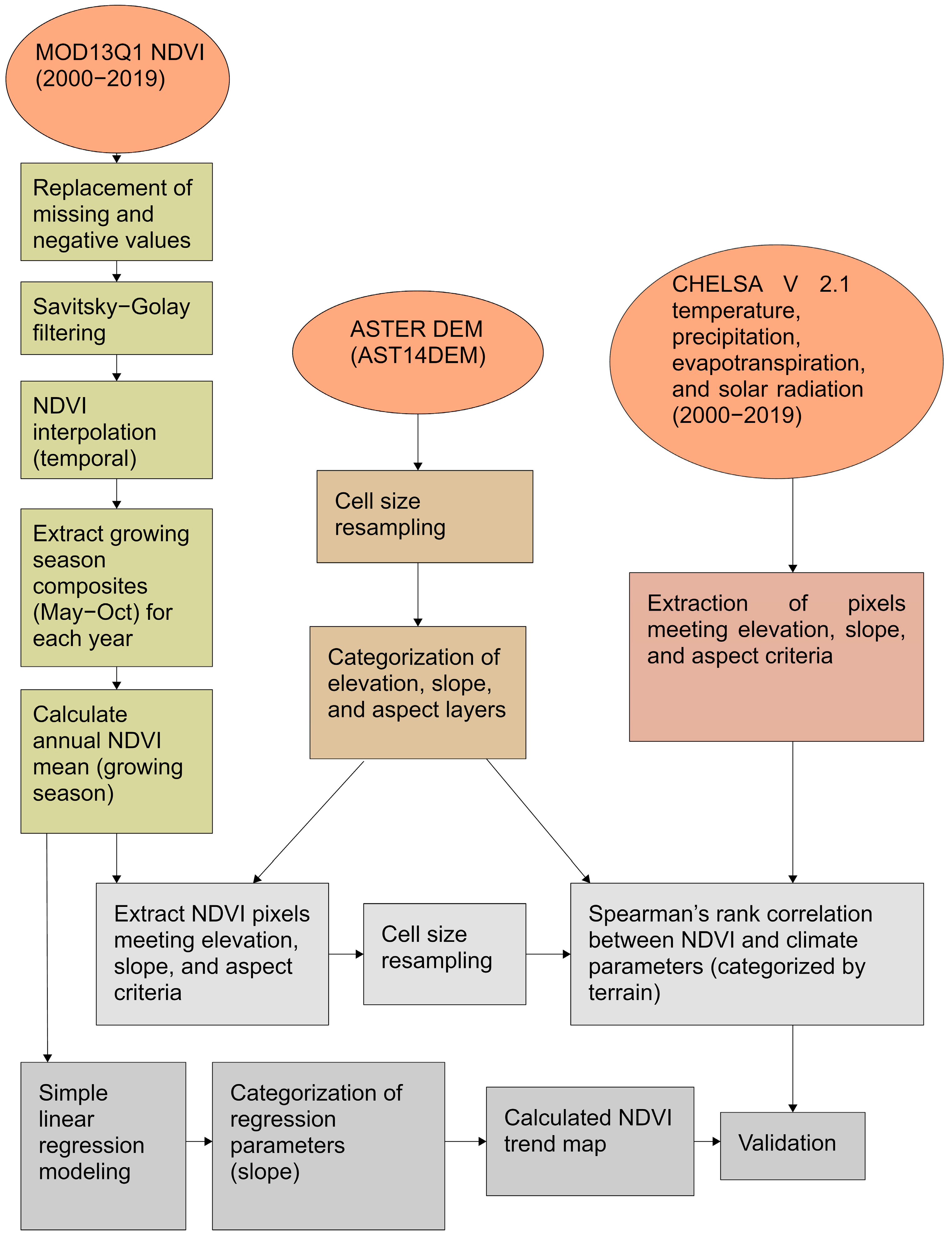
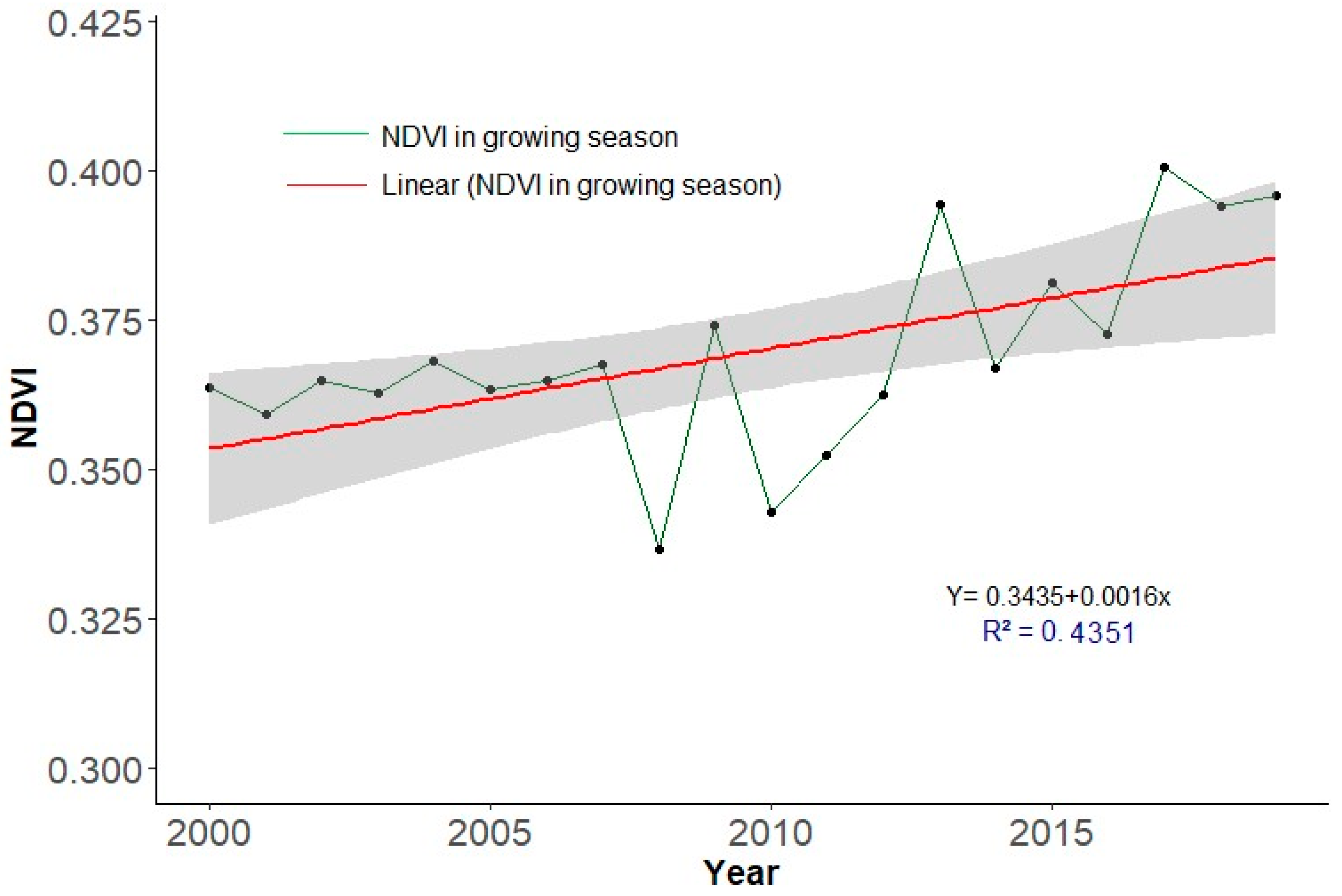

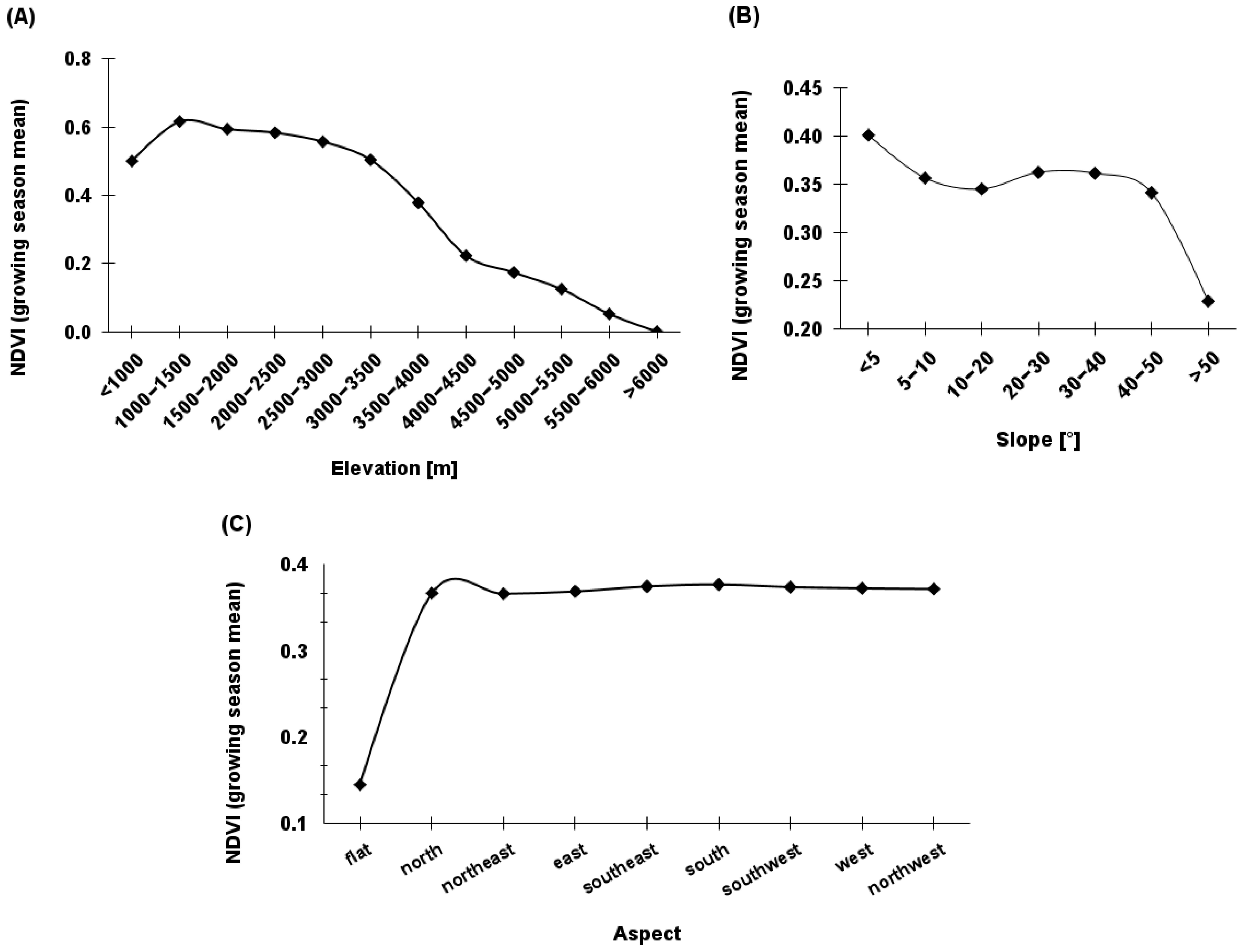
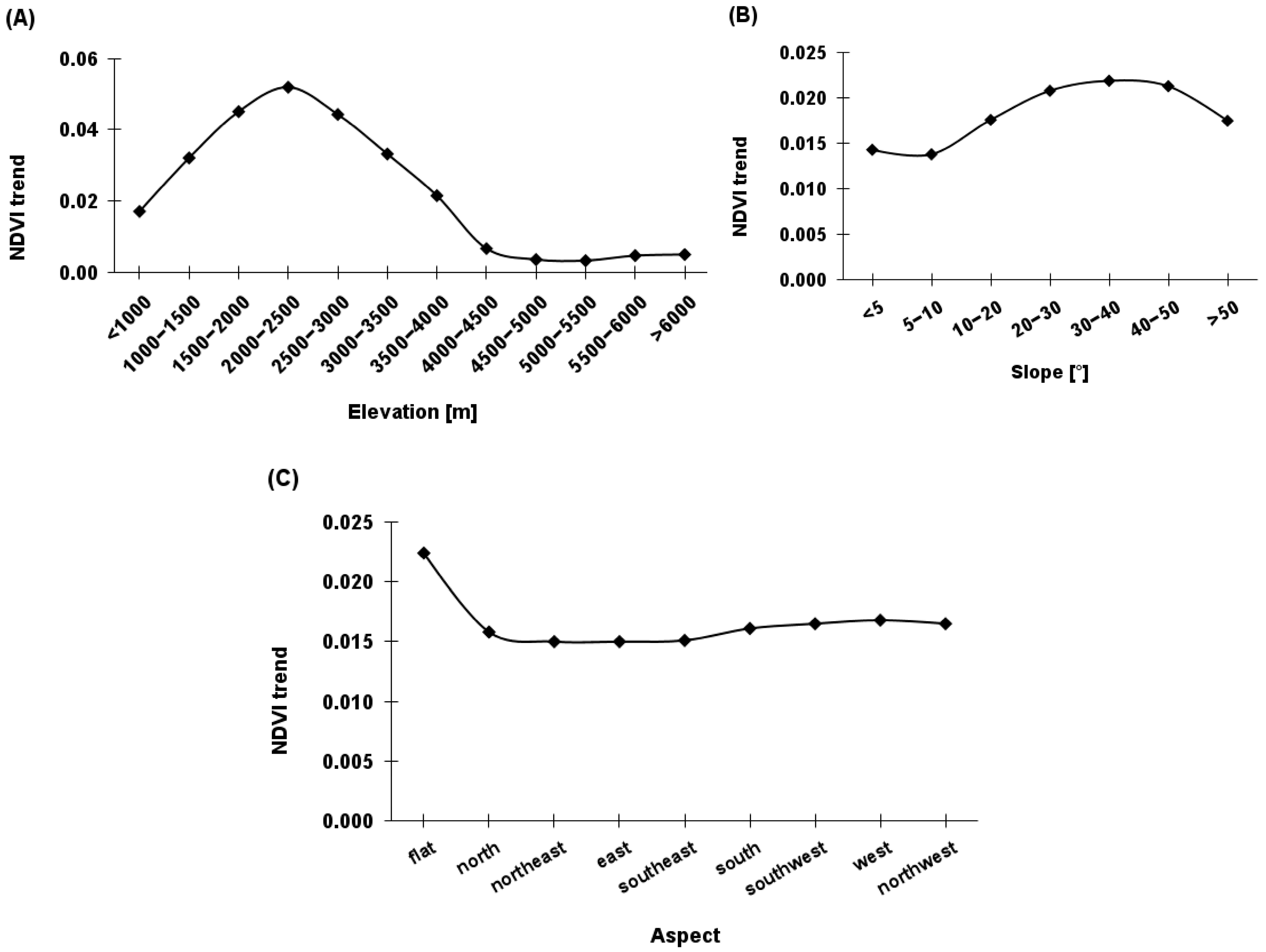


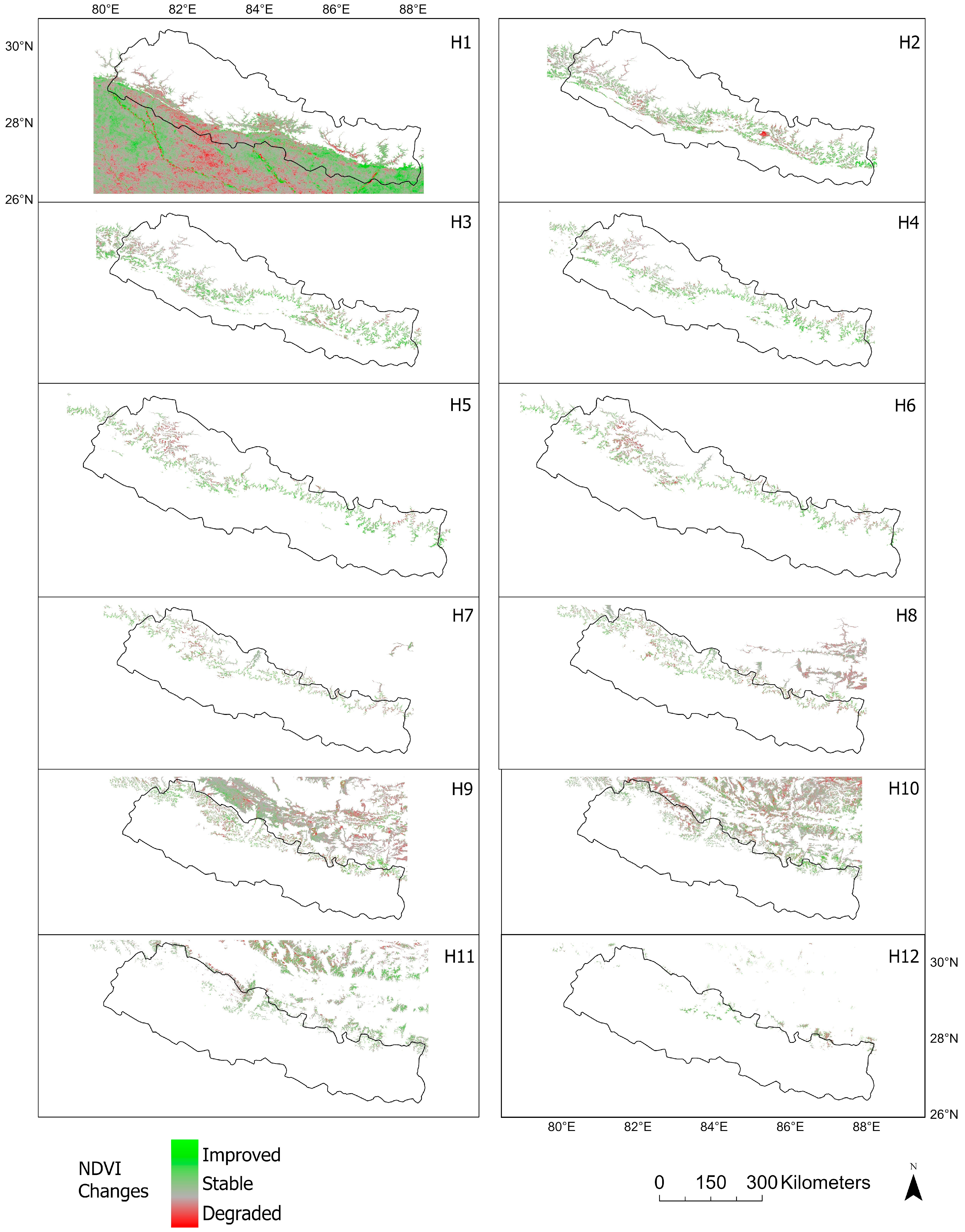
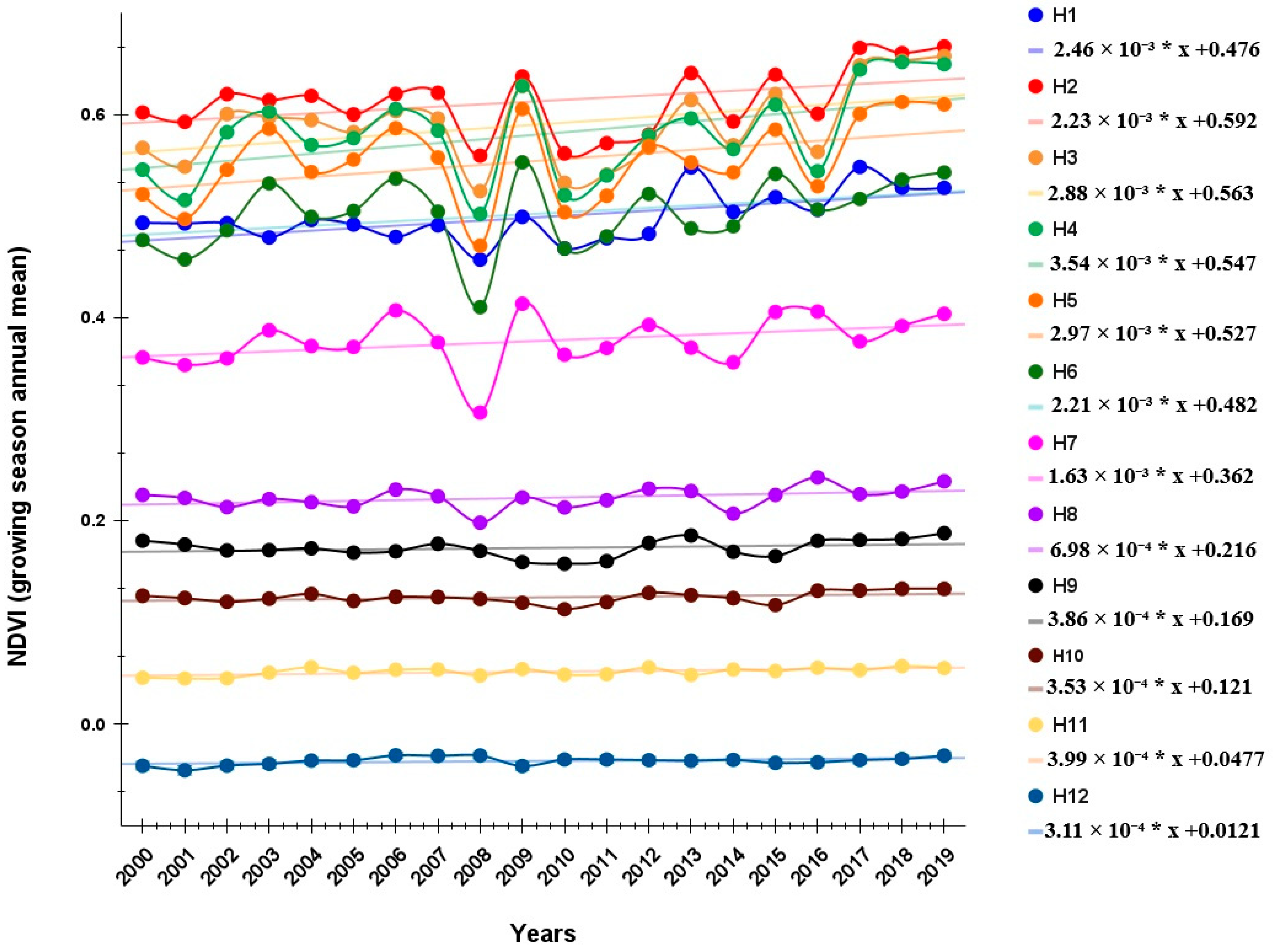

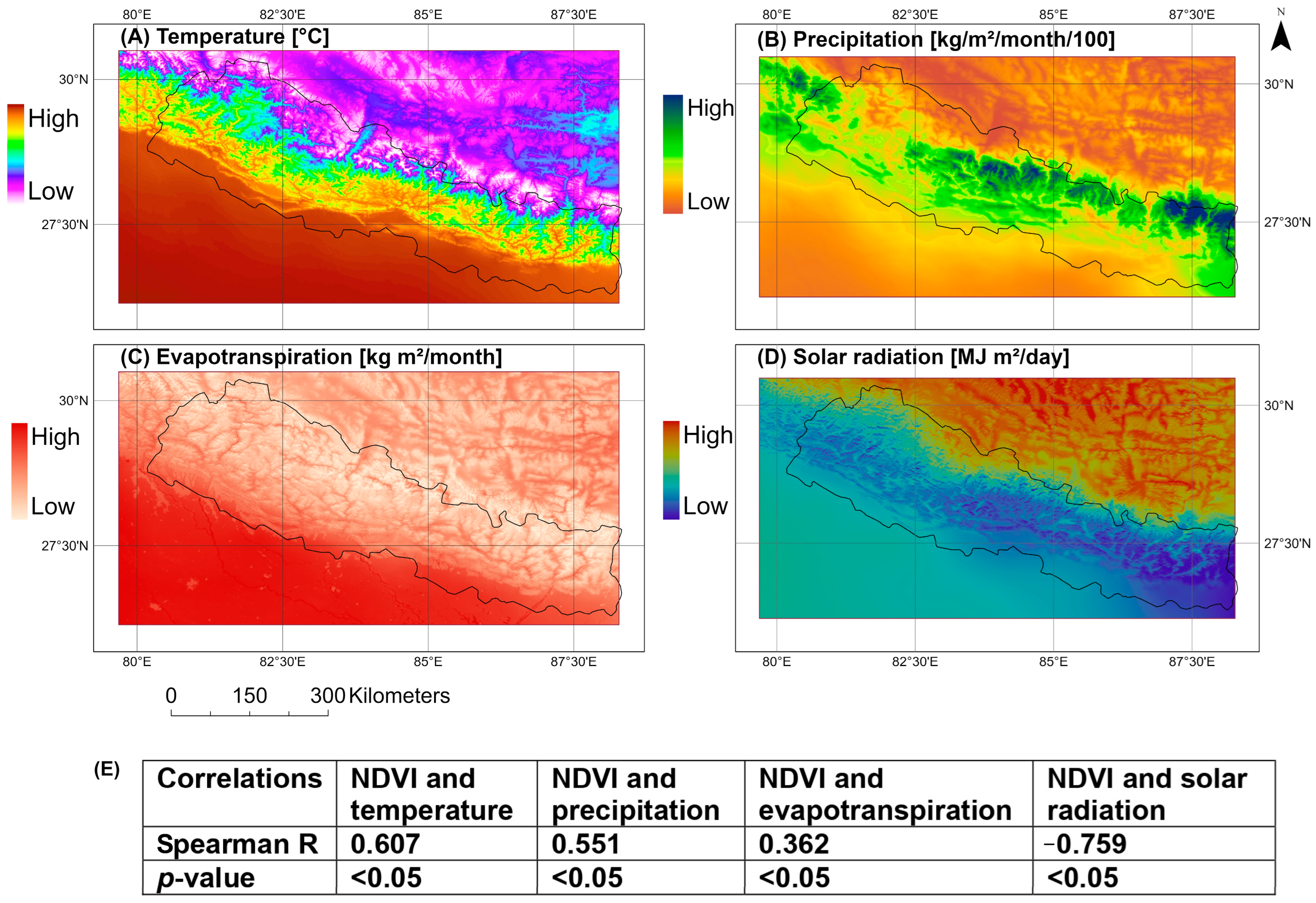
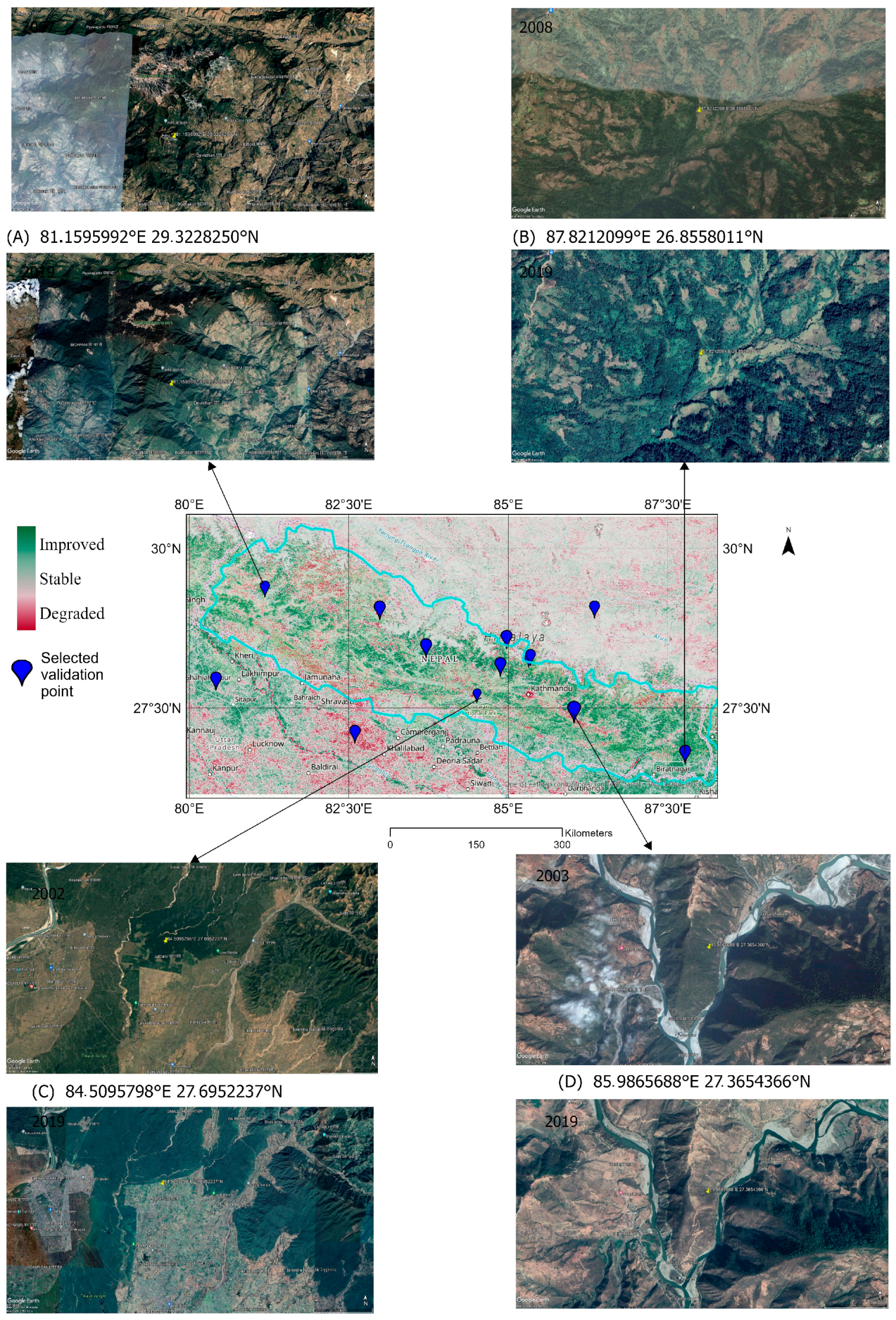
| Elevations (masl) | NDVI and Temperature | p-Value | NDVI and Precipitation | p-Value | NDVI and Evapotranspiration | p-Value | NDVI and Solar Radiation | p-Value |
|---|---|---|---|---|---|---|---|---|
| <1000 | −0.758 | 0.00 | 0.708 | 0.00 | −0.739 | 0.00 | −0.559 | 0.00 |
| 1000–1500 | 0.254 | 0.00 | 0.001 | 0.86 | −0.096 | 0.00 | 0.095 | 0.00 |
| 1500–2000 | 0.098 | 0.00 | 0.008 | 0.20 | −0.082 | 0.00 | 0.140 | 0.00 |
| 2000–2500 | −0.009 | 0.28 | −0.176 | 0.00 | 0.162 | 0.00 | 0.359 | 0.00 |
| 2500–3000 | −0.021 | 0.02 | −0.449 | 0.00 | 0.329 | 0.00 | 0.444 | 0.00 |
| 3000–3500 | 0.116 | 0.00 | −0.455 | 0.00 | 0.278 | 0.00 | 0.347 | 0.00 |
| 3500–4000 | 0.009 | 0.3 | 0.056 | 0.00 | −0.144 | 0.00 | −0.136 | 0.00 |
| 4000–4500 | 0.06 | 0.00 | 0.323 | 0.00 | −0.361 | 0.00 | −0.382 | 0.00 |
| 4500–5000 | 0.194 | 0.00 | −0.125 | 0.00 | 0.205 | 0.00 | 0.148 | 0.00 |
| 5000–5500 | 0.435 | 0.00 | −0.382 | 0.00 | 0.576 | 0.00 | 0.537 | 0.00 |
| 5500–6000 | 0.536 | 0.00 | −0.341 | 0.00 | 0.671 | 0.00 | 0.634 | 0.00 |
| >6000 | 0.311 | 0.00 | −0.217 | 0.00 | 0.131 | 0.00 | 0.236 | 0.00 |
| Slopes (Degrees) | NDVI and Temperature | p-Value | NDVI and Precipitation | p-Value | NDVI and Evapotranspiration | p-Value | NDVI and Solar Radiation | p-Value |
|---|---|---|---|---|---|---|---|---|
| Less than 5 | 0.0121 | 0.00 | 0.7009 | 0.00 | 0.0028 | 0.25 | −0.6295 | 0.00 |
| 5–10 | 0.7027 | 0.00 | 0.6115 | 0.00 | 0.5113 | 0.00 | −0.7514 | 0.00 |
| 10–20 | 0.8820 | 0.00 | 0.5023 | 0.00 | 0.4602 | 0.00 | −0.6930 | 0.00 |
| 20–30 | 0.8919 | 0.00 | 0.3566 | 0.00 | 0.5182 | 0.00 | −0.6642 | 0.00 |
| 30–40 | 0.9076 | 0.00 | 0.2238 | 0.00 | 0.6357 | 0.00 | −0.6236 | 0.00 |
| 40–50 | 0.9283 | 0.00 | 0.0628 | 0.03 | 0.7414 | 0.00 | −0.5924 | 0.00 |
| Above 50 | 0.9332 | 0.00 | −0.0828 | 0.17 | 0.8323 | 0.00 | −0.5325 | 0.01 |
| Aspects | NDVI and Temperature | p-Value | NDVI and Precipitation | p-Value | NDVI and Evapotranspiration | p-Value | NDVI and Solar Radiation | p-Value |
|---|---|---|---|---|---|---|---|---|
| Flat | 0.518 | 0.00 | 0.603 | 0.00 | 0.522 | 0.00 | −0.495 | 0.00 |
| North | 0.763 | 0.00 | 0.491 | 0.00 | 0.413 | 0.00 | −0.704 | 0.00 |
| Northeast | 0.750 | 0.01 | 0.497 | 0.00 | 0.393 | 0.00 | −0.721 | 0.00 |
| East | 0.725 | 0.00 | 0.502 | 0.00 | 0.396 | 0.00 | −0.737 | 0.00 |
| Southeast | 0.732 | 0.00 | 0.496 | 0.00 | 0.410 | 0.00 | −0.742 | 0.02 |
| South | 0.729 | 0.00 | 0.522 | 0.00 | 0.426 | 0.00 | −0.748 | 0.00 |
| Southwest | 0.752 | 0.00 | 0.492 | 0.04 | 0.458 | 0.00 | −0.731 | 0.00 |
| West | 0.736 | 0.00 | 0.486 | 0.00 | 0.451 | 0.00 | −0.725 | 0.00 |
| Northwest | 0.738 | 0.00 | 0.458 | 0.00 | 0.423 | 0.03 | −0.705 | 0.00 |
Disclaimer/Publisher’s Note: The statements, opinions and data contained in all publications are solely those of the individual author(s) and contributor(s) and not of MDPI and/or the editor(s). MDPI and/or the editor(s) disclaim responsibility for any injury to people or property resulting from any ideas, methods, instructions or products referred to in the content. |
© 2025 by the authors. Licensee MDPI, Basel, Switzerland. This article is an open access article distributed under the terms and conditions of the Creative Commons Attribution (CC BY) license (https://creativecommons.org/licenses/by/4.0/).
Share and Cite
Nila, M.U.S.; Bobrowski, M.; Schickhoff, U. Growing Season Normalized Difference Vegetation Index in the Nepal Himalaya and Adjacent Areas, 2000–2019: Sensitivity to Climate Change and Terrain Factors. Land 2025, 14, 749. https://doi.org/10.3390/land14040749
Nila MUS, Bobrowski M, Schickhoff U. Growing Season Normalized Difference Vegetation Index in the Nepal Himalaya and Adjacent Areas, 2000–2019: Sensitivity to Climate Change and Terrain Factors. Land. 2025; 14(4):749. https://doi.org/10.3390/land14040749
Chicago/Turabian StyleNila, Mst Umme Salma, Maria Bobrowski, and Udo Schickhoff. 2025. "Growing Season Normalized Difference Vegetation Index in the Nepal Himalaya and Adjacent Areas, 2000–2019: Sensitivity to Climate Change and Terrain Factors" Land 14, no. 4: 749. https://doi.org/10.3390/land14040749
APA StyleNila, M. U. S., Bobrowski, M., & Schickhoff, U. (2025). Growing Season Normalized Difference Vegetation Index in the Nepal Himalaya and Adjacent Areas, 2000–2019: Sensitivity to Climate Change and Terrain Factors. Land, 14(4), 749. https://doi.org/10.3390/land14040749






